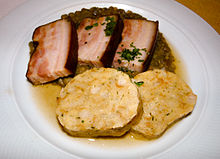Kaiserfleisch
Kaiserfleisch is a name for various, mostly cured and cooked meat products from the back or trunk of the pig . The word comes from the Austrian and Southeast German kitchen language and can refer to different cuts of pork .
The prefix “Kaiser-” is intended to designate particularly good meat, comparable to Kaisersemmel , Kaiserschmarrn , Kaiserbirne and similar expressions.
Ribs
First of all, Kaiserfleisch, especially in older literature, stands for cured and smoked meat from the rib of the pig, so it is more or less to be equated with the smoked rack (Kassel rib spear). Even Friedrich Nicolai , the (published in 1785) his "journey through Germany and Switzerland" an "attempt at Austrian Idiotikon " appends defined:
- Kaiserfleisch, the short meat on the ribs, smoked Kaiserfleisch. speak Cheese meat.
Such square pieces, but also pieces of pork breast - also under the name Kaiserfleisch - are cooked and served as a specialty of Austrian cuisine with sauerkraut and bread dumplings .
The definition in the guiding principles for meat and meat products of the German food book corresponds to this understanding of the word ; according to them, Kaiserfleisch is exclusively from the cutlet , always bone-free, largely freed from fatty tissue , and may - even with the addition of meat - be composed of several strands.
To make it, you take chops from the 6th rib, so no neck. They are triggered , free of bacon, mild salted and short (6-12 hours) cold smoked, then into molds or on a board tied at 80 ° C cooked.
belly
In recent usage in Austria and also in Southeast Germany, however, Kaiserfleisch means smoked pork belly . In Vienna , it can also mean the tender meat of a young pig (young pig noodle ).
Individual evidence
- ^ A b Heinz Dieter Pohl : The Austrian kitchen language. A lexicon of typical Austrian culinary specialties (with linguistic explanations) (= Studia interdisciplinaria Ænipontana . Volume 11 ). Praesens-Verlag, Vienna 2007, ISBN 3-7069-0452-7 , p. 82 ( austria-forum.org [accessed July 28, 2015]).
- ^ A b Paul Kretschmer : Word geography of the high German colloquial language . Vandenhoeck & Ruprecht, Göttingen 1918, keyword "Kassler Rippespeer", p. 266–267 ( Text Archive - Internet Archive ).
- ^ Hermann Paul : German dictionary . 9th, completely revised edition. Niemeyer, Tübingen 1992, ISBN 3-484-10679-4 , keyword "Kaiser", p. 444 .
- ↑ Friedrich Nicolai: Description of a journey through Germany and Switzerland, in 1781 . tape 5 . Berlin / Stettin 1785, Beylage XIV, p. 102 of the supplement ( online ).
- ↑ Erhard Gorys : dtv kitchen dictionary . Deutscher Taschenbuch Verlag, Munich 1977, ISBN 3-423-03140-9 , keyword "Keizerfleisch", p. 220 .
- ^ F. Jürgen Herrmann: The great lexicon of dishes . Pfanneberg, Haan-Gruiten 2012, ISBN 978-3-8057-0513-4 , pp. 457 .
- ↑ German food book, guidelines for meat and meat products
- ↑ Hermann Koch: The manufacture of fine meat and sausage products . 18th edition. Deutscher Fachverlag, Frankfurt 1986, ISBN 3-87150-236-7 , p. 175 .
- ^ Ulrich Ammon: Variant Dictionary of German . de Gruyter, Berlin 2004, ISBN 3-11-016575-9 , keyword "Kaiserfleisch", p. 381 .
- ↑ Jakob Ebner: How do you say in Austria? Dictionary of Austrian German . 4th, completely revised edition. Dudenverlag, Mannheim 2009, ISBN 978-3-411-04984-4 , keyword "Kaiserfleisch", p. 193 .
